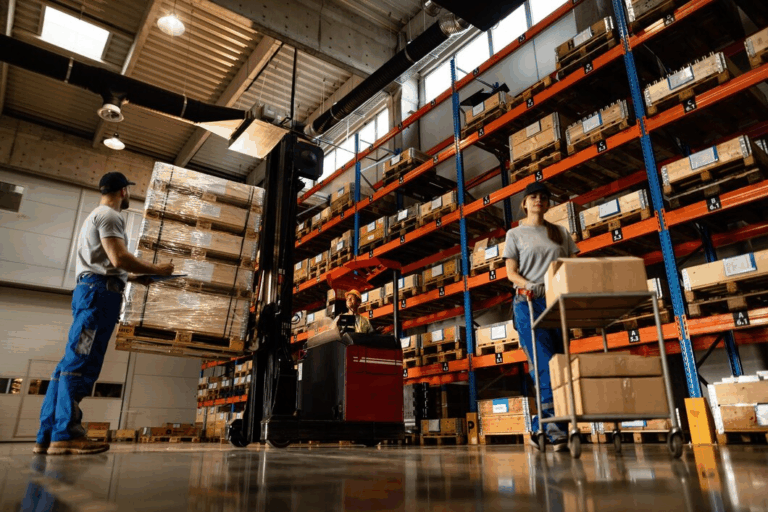Warehouses are no longer just storage spaces—they are the nerve centre of efficient order fulfilment. As online shopping accelerates and customer expectations soar, businesses must rethink how their fulfilment warehouses operate. From smart layouts to automated tracking, warehouse optimisation isn’t just about saving space—it’s about delivering better, faster, and more accurately.
If you’re looking to scale your eCommerce fulfilment or need robust warehouse storage solutions, these strategies will help you future-proof your fulfilment infrastructure and stay ahead in a competitive logistics landscape.
Assessing Current Warehouse Layout and Flow
An optimised warehouse layout improves movement, reduces travel time, and prevents bottlenecks. A poor layout, on the other hand, leads to inefficient workflows, misplacement of stock, and slower fulfilment cycles. Conducting a layout audit is the first step in identifying and resolving hidden inefficiencies.
Common inefficiencies to address
Many warehouses struggle with outdated shelving, overstocked aisles, or poor segregation of fast- vs slow-moving goods. Overlapping zones for receiving, packing, and shipping can also create delays. Identifying these inefficiencies allows you to redesign space usage and streamline material flow.
Mapping workflows for improved productivity
Map out how products move through your warehouse—from receiving to shelving, picking, packing, and shipping. A visual representation helps uncover movement redundancies and layout conflicts. Solutions may include installing direct pick routes or consolidating staging areas.
Lama Fulfilment uses this data-centric approach to layout planning to ensure maximum throughput and minimal disruption in client warehouses.
Implementing Smart Storage Solutions
Space optimisation is vital for any growing business. Intelligent storage solutions increase storage density and improve inventory access without the need for costly expansions. They also simplify the retrieval of products, saving time during picking and packing.
Vertical racking and shelving systems
Vertical space is often underutilised. Installing multi-level racking allows for storing more units in the same footprint. High-bay shelving paired with mechanical lifts or forklifts increases cubic utilisation and keeps the floor space free for movement.
This method is ideal for warehouse storage solutions with high inventory turnover and varied SKU sizes.
Dynamic slotting for inventory access
Dynamic slotting is the practice of placing fast-moving products in easily accessible zones and reshuffling slot locations based on demand trends. This reduces picker travel time and ensures that popular items are always ready for rapid dispatch.
Lama’s eCommerce fulfilment services leverage dynamic slotting to boost pick efficiency during seasonal spikes and promotions.
Technology Integration in Warehouse Management
Digitisation is at the heart of warehouse optimisation. Integrating technology streamlines tasks, increases accuracy, and provides real-time visibility across all inventory and operations. Whether it’s a full-scale WMS or simple scanning tools, tech adoption delivers measurable ROI.
Benefits of WMS and automation tools
A Warehouse Management System (WMS) enables real-time inventory tracking, automatic replenishment alerts, and efficient order processing. It integrates with sales channels and shipping partners for end-to-end fulfilment management.
Automation tools like conveyor belts, pick-to-light systems, and robotic sorters further accelerate order cycles. Lama Fulfilment incorporates WMS platforms tailored to your business model, improving operational accuracy and warehouse speed.
Barcode and RFID tracking systems
Barcodes and RFID tags enable item-level tracking, improving inventory control and reducing misplacements. RFID provides real-time item location and status, while barcodes support fast scanning during picking and packing.
When implemented correctly, these systems enhance stock visibility, lower error rates, and make audit trails effortless—critical for both retail and B2B fulfilment scenarios.
Labour Efficiency and Workforce Planning
Even in highly automated environments, people remain essential to fulfilment success. Optimising warehouse workforce performance through structured planning and ergonomic design leads to higher output and reduced burnout.
Cross-training warehouse teams
Cross-training ensures that employees can switch between tasks based on demand—packing during peak order windows, or replenishing shelves during off-hours. It builds team agility and reduces downtime.
This also helps smaller warehouses maximise limited staff without compromising service levels. Lama often deploys workforce rotation systems to meet client SLAs during promotional or seasonal surges.
Ergonomic workspace and task design
Designing ergonomic workstations for tasks like packing, labelling, and lifting reduces strain injuries and speeds up operations. Adjustable workbenches, anti-fatigue mats, and vertical storage access tools improve staff comfort and productivity.
Inventory Accuracy and Control Tactics
Poor inventory control leads to out-of-stocks, overstocking, and fulfilment errors. Ensuring accuracy through regular audits and automated reconciliation is essential for customer satisfaction and operational success.
Cycle counting vs physical inventory
Cycle counting breaks down inventory checks into small, manageable tasks done daily or weekly—versus traditional full counts, which are disruptive. This continuous process helps identify stock discrepancies early and maintains real-time accuracy.
Warehouse teams at Lama Fulfilment use cycle counting protocols to minimise business interruptions and reduce the need for full shutdowns.
Reducing picking and packing errors
Errors in picking and packing directly impact customer experience. Barcoding systems, mobile scanners, and pick-to-light setups dramatically reduce human mistakes. Real-time validation systems can catch discrepancies before packages leave the dock.
Accurate labelling and visual confirmation during packing ensure that each order meets your brand’s fulfilment standards.
Safety and Compliance in Storage Practices
A safe warehouse is an efficient warehouse. Poor safety practices increase the risk of injuries, inventory damage, and compliance violations. Ensuring that your storage layout and handling procedures align with industry standards is key to sustainable fulfilment operations.
Organised layouts for reduced hazards
Disorganised zones and cluttered aisles create tripping hazards and impede emergency access. Designing wide, clearly marked pathways and separating pedestrian areas from equipment routes helps minimise risk.
Lama’s storage services prioritise clean layouts and lean principles to enhance safety and workflow simultaneously.
Following regulatory storage guidelines
Compliance involves following health, safety, and fire regulations, including proper racking systems, load limits, and hazardous material segregation. Routine audits and safety training are critical to meeting legal and operational standards.
Whether you’re handling electronics, apparel, or consumables, Lama ensures your fulfilment practices meet UK regulatory frameworks and ISO 9001 standards.
Conclusion
Warehouse optimisation is no longer a ‘nice to have’—it’s essential for competitive fulfilment. By auditing your layout, adopting smart storage, leveraging technology, and prioritising workforce efficiency, you unlock faster order turnaround and greater accuracy.
Whether you’re scaling your eCommerce operations or fine-tuning B2B logistics, every warehouse strategy should be tied to customer satisfaction and operational scalability. To know more about our services visit Lama Fulfilment. We offer tailored warehouse storage solutions, integrated tech platforms, and scalable staffing to match your growth. Whether you need eCommerce fulfilment or multi-channel logistics support, we’re here to optimise every square foot of your space.
Frequently Asked Questions
What is warehouse optimisation in fulfilment?
Warehouse optimisation is the process of improving storage layout, workflows, technology, and workforce efficiency to increase the speed and accuracy of order fulfilment. It also enhances safety, reduces costs, and ensures better space utilisation.
How can technology improve warehouse efficiency?
Technology such as Warehouse Management Systems (WMS), barcode scanners, and RFID tracking enhances inventory accuracy, reduces picking errors, and streamlines fulfilment processes. It enables real-time monitoring and faster decision-making.
What are smart storage solutions for small warehouses?
Smart storage solutions include vertical racking, modular shelving, and dynamic slotting. These systems help maximise limited space while keeping frequently ordered products accessible ideal for growing fulfilment needs.
Why is inventory accuracy important in fulfilment?
Accurate inventory ensures you always have the right stock in the right place, reducing out-of-stock situations and preventing overordering. It also leads to better customer satisfaction and fewer order errors.
What tools help improve picking accuracy?
Barcode scanners, pick-to-light systems, voice-directed picking, and mobile devices help warehouse staff select the correct items. These tools reduce human error and increase overall order accuracy










